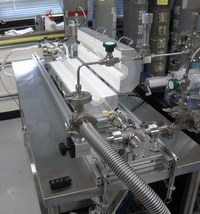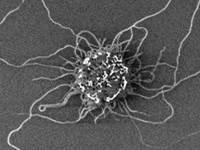Research:Chemical vapor deposition of single-walled carbon nanotubes
There exists various methods for synthesizing carbon nanotubes, and we use alcohol catalytic chemical vapor deposition. Using metal particles as catalyst, growth of single-walled carbon nanotubes occurs when alcohol is introduced into a heated furnace to react with the catalyst. Our setup is based on that of Maruyama group.


Using this growth method, it is possible to synthesize carbon nanotubes directly on substrates. Carbon nanotubes are very sensitive to the surface condition, with all the atoms being on the surface. Nanotubes are cleanest right after the growth, and therefore these exhibit excellent electrical and optical properties. Of course, there won't be any nanotube growth without the catalyst, so it is possible to pattern the catalyst area and grow nanotubes only where we want them.